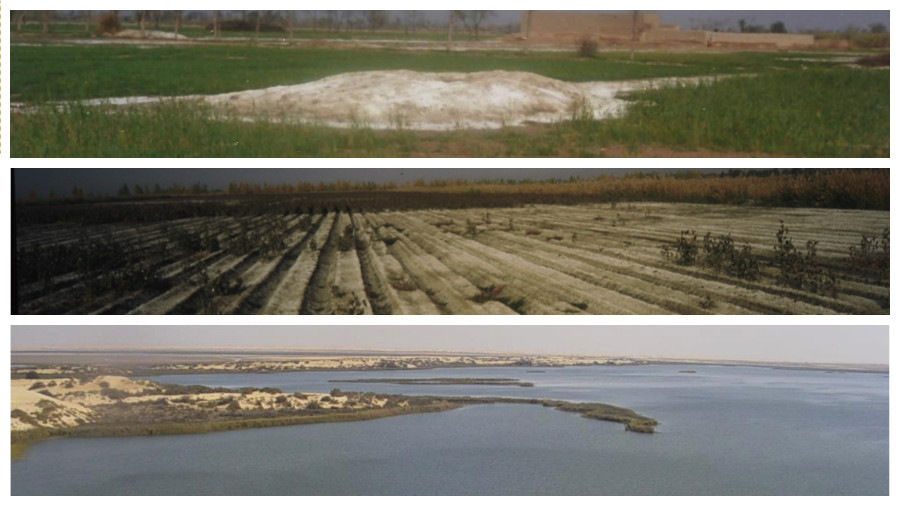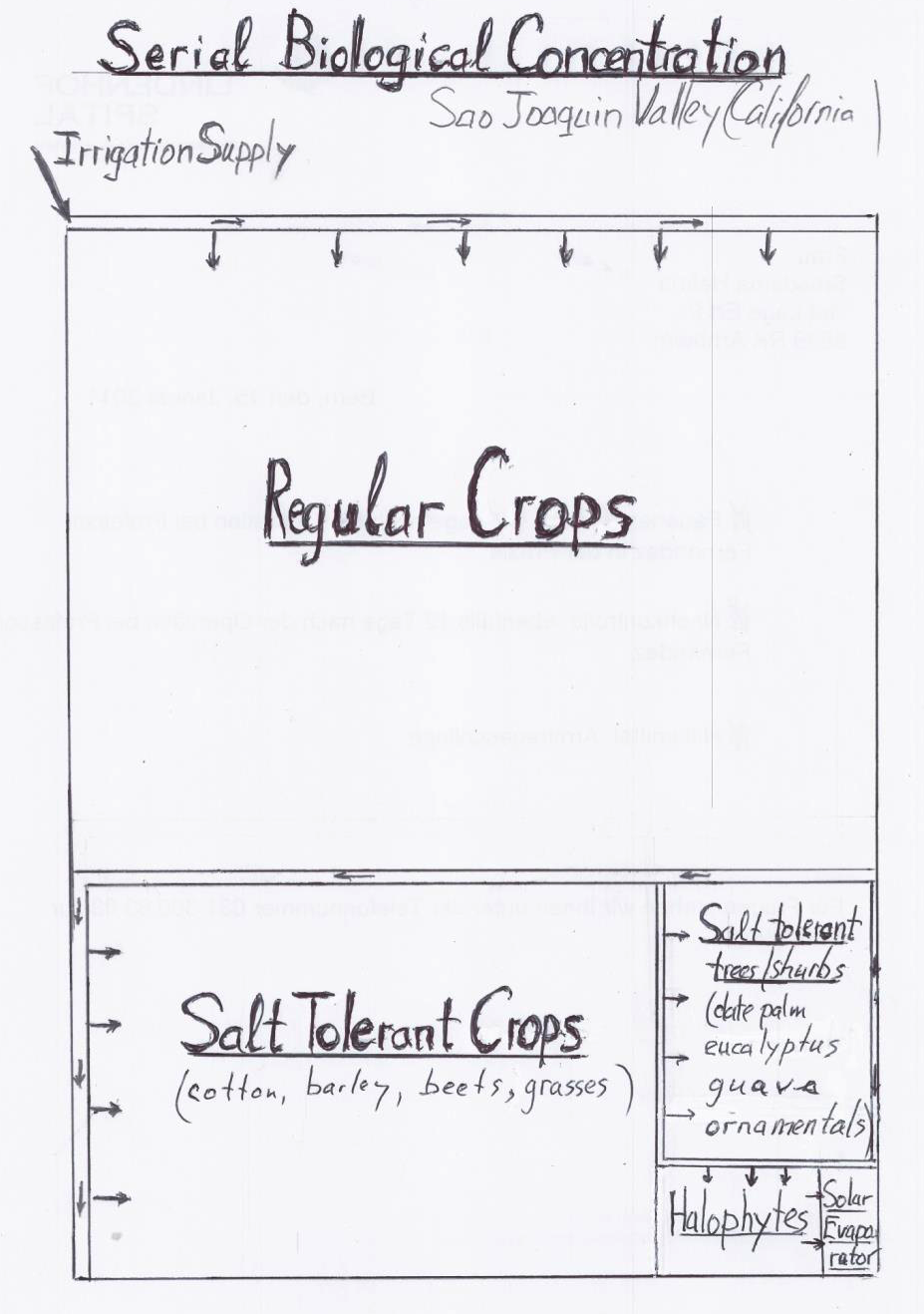Contribution from Lambert K Smedema, Arnhem, the Netherlands (lambertsmedema@hotmail.com)
February, 2016
Salinization hazards of arid zone irrigation: a casual review of a current state and ongoing developments
Introduction
The arid zone constitutes a naturally highly saline environment. Irrigated crop production in this zone enhances this natural propensity as it evapotranspires large amounts of water, and in the process concentrates large amounts of salt. Irrigation development also risks the mobilization of (part of) the large quantities of primary and fossil salts residing within the exploited depths in almost all arid-zone landscapes. Salts accumulate in the root-zones of irrigated lands. There, salt concentrated evapotranspirative processes take place while much of the salt disposal needed to control the land salinization naturally ends up in the rivers; the natural salts sinks of the landscapes. Irrigated crop production in arid zones is in fact collaterally a highly onerous salt concentration process in which either the land or the river-disposal areas are liable to get salinized.
 Above: Salt heap in farmers field in Central China (farmer having cleared the surface salts from his field by hand-scaping and piling the salt in the centrum of the field)
Above: Salt heap in farmers field in Central China (farmer having cleared the surface salts from his field by hand-scaping and piling the salt in the centrum of the field)
Middle: Abandoned salt field in Pakistan
Below: Evaporation pond in Pakistan
Waterlogging and Salinization
The alarming waterlogging and salinization problems of the mid-20th century were mostly a legacy from the late 19th/early 20th century’s large scale irrigation developments in the arid zone. Temporal low efficiency technologies, characterized by grossly leaking unlined canals and uncontrolled watering of the fields, were used. Most of these early irrigation developments have since reached stability, whereas most of the later developments used improved water management practices and technologies. The increased groundwater use, mostly in the form of small scale tube well pumping by private farmers, has particularly greatly helped control the waterlogging and salinization problems; falling rather than rising watertables have become the main concern in many irrigated arid zone areas. The problems are now largely restricted to: those areas underlain by saline groundwater and/or by unsuitable groundwater pumping conditions; and to countries where the installation of drainage systems has not yet kept up with the needs. As what will be discussed further on, the salinity hazards faced by irrigation development in arid zones are however not limited to the above discussed classic waterlogging and salinization problems.
| Classic Waterlogging and Salinization actually concerns two quite different processes (i.e. rising watertables and salt accumulation in the upper soil layers). These processes may actually also occur separately. In the most problematic case, these two processes are however related and occur coincidentally. Although most of the commonly applied control measures are primarily focused on the control of the waterlogging component, these measures also helped control the salinization processes since in most cases the two processes are indeed related. |
Irrigation Efficiency and Salinity Control
Present salinity control in the irrigated lands of arid zones in the developing countries generally relies heavily on the still adequately available irrigation water resources, and on the prevalent low (field) irrigation efficiencies. The high deep percolation losses help control the soil salinity by leaching the soils, while the relatively fresh drainage return flows help control the salinity of the river disposal areas. This mode of contribution to the salinity control may, however, come under threat when in the future, in response to emerging fresh water scarcity concerns. The irrigation sector may thus be forced to drastically improve its water use efficiencies. All four major water use sectors (agriculture, industry, drinking and domestic purposes, and environment) are expected to need more water in the future. Most of these extra needs for the first three water-use-sectors are based on population growth. On the other hand, the environmental claims are based on the need to reduce the current over-exploitation of rivers and other fresh water resources since they are endangering the local and regional eco-systems. In most of the involved arid zone countries, irrigation is at present the major and largest water consumer, typically using 80-90 % of the available fresh water in the world. Improving the irrigation water use efficiency would plausibly be the best response of the sector to meet the to-be-expected future demands and competition over fresh water. Dedicated measures would be needed to compensate for the loss of the salinity control function of the current high irrigation water losses. Otherwise, it is unlikely that the present levels of land and river salinity control can be sustained.
Salt Disposal and River Salinization
Salt balance maintenance in irrigated land in arid zones requires leaching and a consequent disposal of saline drainage water. While the volatile expansion of pumping out groundwater has greatly helped bring the classic waterlogging and salinity problems under control, it has also considerably enlarged the salt disposal need. The pumped groundwater often contains more mineralized and mobilized salts from deeper layers, which may add to the salt disposal load. The natural disposal of a river to the sea or to other terminal sites generally remains an acceptable mode of disposal as long as the disposed volumes are limited and can readily be accommodated by downstream river’s water users. Improved drainage, used to combat high levels of land salinization or reclaim abandoned salinized lands, creates large salt disposal needs, which when disposed in rivers they’ve resulted in considerable river salinization impacts. To cope with such large salt disposal needs, special outfall drains have been constructed in some basins. Those drains pick up the saline drainage water before it reaches the rivers, and transport it separately from the river to the sea. In cases where no nearby safe outlets are available, the saline drainage water may possibly be disposed into the adjoining low lying desert areas where they form (depending on the topography) more or less extensive evaporation ponds. Locally, other options may be available but these mostly suffice only to cope with minor salt disposal needs. Lack of all-round satisfactory means of salt disposal has in some cases put constraints on the salinity control of the involved irrigated land. It therefore has become a concern of strategic significance to the sustainability of irrigated agriculture in some major food producing basins in arid zones, as well as to the salinity control of the involved river systems.
Ongoing Developments
While the classic waterlogging and salinization problems may have become more or less under control, the above discussed water scarcity concerns and salt disposal constraints make it clear that salinity problems of irrigated agriculture in arid zones are far from solved. In some cases the conventionally applied remedial measures might still suffice. However, generally it is to be expected that the sustainability in this sector will increasingly depend on the sophisticated water and salinity management practices as applied in the San Joaquin Valley, California and in some other parts of some advanced countries. (Salinity control heavily relying on precision irrigation, reuse of drainage water and final disposal to wetlands, on-farm evaporation ponds and solar evaporators as well as enforcement of new environmental regulations; for further specifics see FAO Irrigation and Drainage Paper no 61, 2002). So far these practices are applied at a limited scale only, and it is as yet far from clear whether they will eventually provide answers to the identified challenges. It is however clear that not all arid zone countries facing salinity-related sustainability problems presently have the economic means and the technical capacity to adopt to the San Joaquin type water management practices. Much further research and best-practices development work remains to be done to reach wide applicability and acceptability.
The San Joaquin water management practices were developed in response to specific local emergencies, i.e. limitations imposed on the drainage disposal to the San Francisco Bay; selenium contamination of the groundwater; and closure of the Kesteron drainage outfall. Similar practices may ultimately be needed in more irrigated areas in arid zones. However, intermediately less demanding practices may suffice. Those practices are such as the ones used/experimented with in: some parts of Australia/Murray-Darling (introduction of disposal permits); Egypt (drainage water reuse, directly and by blending); India/Haryana (shallow watertable management, salt disposal during seasons of high river discharge); and Pakistan (drainage water reuse for saline agriculture).
|

